Read more about the spots this map has picked out here
Category Archives: Downtown/Old Fourth Ward
Underground Atlanta
Before Atlanta grew to be the biggest city in what is known as the Empire State of the South, it was the home of the Zero Milepost. The Zero Milepost marked the endpoint of a 138-mile railroad that started in Chattanooga. Around that endpoint, a bustling railroad city called Terminus began to form.
General William Sherman ran his Union soldiers through Terminus, burning most of it to the ground. However, the people remained resilient and again built around the milepost. Viaducts, or types of bridges, were built in the 1920’s. All the shops moved up, abandoning underground roads and aged storefronts below.
The forgotten places beneath became what is Underground Atlanta today. Plazas were constructed above starting in 1943, but in 1969 The Underground once again became the home to shops. The stores no longer resembled Jacob’s Pharmacy, the first store to sell Coca-Cola in 1866. Where people first took sips of Coke, they now buy vibrant Jordan shoes from Foot Locker.
Falling in behind the modern retail stores, chain restaurants and nightclubs moved in. Next came the Pac-Man Play Arcade. A sharp contrast to the history that surrounds it, the arcade breaks up the musty darkness with its lively music and brilliant lights.
On one side of the Underground sits a classical diner, Johnny Rockets. On the opposite half, dozens of kiosks reside, selling smartphones and rap mix tapes next to concrete blocks where old hotels stood nearly 200 years ago. Take a stroll from the historical side to the opposing MARTA station entrance, and you can see how Terminus became Atlanta and how it got from there to here.
The Underground has experienced a number of closings and reopenings for a variety of reasons. The war, MARTA, crime, and other reasons that lead to lack of retail eventually caused Atlanta to look for another solution. In mid-March, the city bought out the rest of the lease that The Underground had and now it looks to sell the subterennean mall to anyone with a plan for the area. The timeline below will help put the ups and downs of the plaza into a more visual perspective.
[timeline src=”https://docs.google.com/spreadsheet/pub?key=0AszXIVg64TwJdHhqbEkxVUFLbm1EcjlRdkhEbU5iWGc&output=html” width=”100%” height=”650″ font=”Bevan-PotanoSans” maptype=”toner” lang=”en” ]
The 1970’s was probably the only decade that the Underground Atlanta really enjoyed any success over a period of time. The gallery below features some of the advertisements that a pedestrian would find while walking through the Underground for the restaurants and bars that were open.
The ER crisis
Click here for a podcast version of this news story
The E.R. Crisis. What’s causing us to choose emergency medical care, and the steps we need to take before the crisis becomes a disaster.
Dale Davis has no college degree, no medical training, but could be considered an expert on the inner workings of a hospital emergency room. He suffers from cirrhosis of the liver, gout, and cognitive disabilities from a traumatic brain injury from a motorcycling accident. Due to this impressive list of ailments, he visits his local E.R. about three times a month, sometimes more. “There’s no comfort level at all in a big city hospital,” says Davis. “I know a lot about…metro hospitals where there is a lot of chaos in the emergency room, a lot of waiting.”
According to Davis’ experience, not everyone that comes to the E.R. is in critical condition. “Some of the people that are there, are there just for the sake of being there and aren’t really there for an emergency at all. And then some of the people there that are really there for emergencies, can suffer greatly.”
This chaos that Davis mentions, is the re-emerging and troubling trend that experts call “The E.R. Crisis.” The E.R. Crisis is a blanket phrase for the overcrowding of emergency rooms nationwide, especially in urban, densely populated places like Atlanta. The New England Journal of Medicine has published that visits to the E.R. have increased 26 percent since 2006. Why they are increasingly more crowded is a matter of opinion, and varies based on who you talk to. When it comes down to it, there are three possible answers; limited access to healthcare, diminished funds for hospital emergency care, or limited access to primary and preventive care options.
Dr. Stephen Pitts, doctor of Internal and Emergency Medicine at Grady Memorial Hospital, says lack of primary care physicians is a driving force of these mounting numbers. “People try to go to their doctor, but they can’t get in,” says Pitts. “To stay in business in primary care, you have to see another patient every fifteen minutes. If they can’t do that, they have to fire their office staff. Economic forces have put them in a bind, it makes them not able to give people the care they want to.” Dr. Pitts says that lack of access to primary care physicians is because of their unwillingness to accept uninsured patients and their preference for other private, more profit resulting insurance plans.
But it’s not the uninsured populations who are filling up E.R. beds. “The fact is the uninsured come to the E.R. less than other categories of patients. They’re worried about having a bill, and wait longer to be seen,” says Pitts. “Medicaid patients have the highest rate of visits, something like 50 to 60 people out of 100 in a year.”
In fact, with the Patient Protection and Affordable Care Act, the year 2014 is expected to cover 16 million more Americans with the Medicaid insurance plans. That is 16 million more people newly insured, and perhaps more likely to visit their local E.R. The projected data is troubling for most city hospitals. When the Medicaid expansion is implemented, the previously uninsured patients may no longer be concerned about the big bills, and may adopt the visiting frequencies of the patients who are currently on Medicaid.
The government is anxiously developing a solution to this impending aggravation of the E.R. Crisis. To stem the influx of emergency room patients, the government is developing programs to entice primary care physicians to be more likely to accept Medicaid insured patients. By offering more monetary incentives to take on these patients, the government hopes to lessen the burden of the emergency rooms, and channel patients to begin to choose primary and preventative avenues, rather than emergency care options.
Despite these measures, the initial stages may still be devastating. To some experts, the problem is the cost burden of E.R. visits and the toll it takes on the entire system.
Michael Rovinsky, President of Integrity Consulting Group, a healthcare consulting group based in Atlanta, says the E.R. is the currently the most expensive endeavor of the entire healthcare system and will continue to be.
The E.R. is the biggest problem in healthcare, says Rovinsky. “It is overused by people who do not have a critical condition. The worst part of emergency care, is it’s the most expensive kind of healthcare. It costs the payers of healthcare a tremendous amount of money.” According to Rovinsky, the behavior, and the culture of the population who uses the E.R. as a primary care solution, will be among the hardest thing to change.
Likewise, many lawmakers are not in favor of the law, and will further hinder primary care expansion to prevent extreme overcrowding in emergency departments. Rovinsky says, this will only worsen the current problems. “A number of governors across the country are against the expansion of Medicaid. Hospitals treat patients anyway, without any money. It’s in their best interest to accept the expansions, because it’s costing the system more money without it. The ultimate goal is the overall reduction of healthcare costs for the entire population.”
More importantly, there is an underlying issue that is often neglected and failed to be targeted in government acts or motions of reform. Patient responsibility is also a topic this rarely mentioned. If everyone was insured, everyone had a primary care physician, and everyone had access to these programs, people still will continue to get acutely ill.
Rovinsky says, it’s because of an unwillingness of some patients to take care of themselves. He explains it simply that the biggest cost to healthcare is using healthcare services. Things that prevent acute illness lessen the amount of money being spent. Simply stated, yet rarely understood, or even mentioned in public debate.
“Anything that leads to poor health, tremendously increases the cost of healthcare,” says Rovinsky. “The big thing that no one will speak about is personal responsibility for wellness. The obesity crisis, the diabetes crisis, drives the cost of healthcare up. The public should take personal responsibility for living a healthier lifestyle. That’s the missing piece in the healthcare discussion.”
All in all, even if all these reforms and preventive measures take a successful hold, the healthcare world is just a world of maybes. Maybe people will seek primary care physicians instead of the emergency room. Maybe primary care physicians will take to the incentives to take on Medicaid patients.
Maybe, maybe not.
In the meantime, the crisis will rage on. Until 2014, it is very unlikely experts will have a clear vision of the new horizons of healthcare. People like Dale Davis will continue to be subject to an increasingly burdened system, with a very foggy future.
But he remains optimistic about the quality of care he receives. “I’ve been extremely lucky,” says Davis. “I’ve been uninsured through times of my life, and I haven’t always been fortunate enough to get the care I needed. But it comes down to taking care of yourself too. You stop drinking, you stop treating your body badly, and you can save yourself a lot.”
With eagerness in his voice, he looks forward to his placement on the transplant list for a new liver later this month. Davis also acknowledges the importance of personal responsibility in healthcare, and claims it’s what turned his life around.
“Yeah, it comes down to you. How badly you want the second chance. You have to prove you want to be healthy, you need to prove you deserve the new life. There’s always someone around the corner who may need it more than you, and that may be the one thing that will scare you straight.”
Rebuilding the railway
The photos throughout this article track the walk along the BeltLine’s Eastside Trail, starting from the entrance at 10th Street and Monroe.
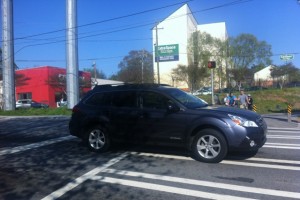
I went the wrong way the first time I tried to use the Eastside Trail.
In my defense, it starts as an extension of Piedmont Park, and that’s where it looks like the real green is. It’s hilly, it’s vibrant—it’s what a green space should look like. The Eastside Trail, on the other hand, is asphalt.
But then, you realize this is where all the joggers, bikers, families and regular trail-goers in sight are headed. No one’s turning the corner: everyone wants to be here. And they’re all approaching a giant burst of color—a mural painted on an overpass, seemingly out-of-place in this industrial area.
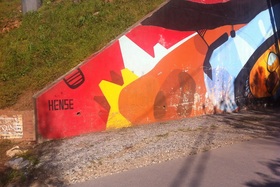
This big weird mural is, though, a design by Atlanta-based graffiti artist Hense, and part of an initiative that spans the whole city. The Eastside Trail of the Atlanta BeltLine, and its respective Art on the Atlanta BeltLine program, is the newest opening in an assembly of several trails around the city that aims to, one day, connect all of the city’s neighborhoods in a movement-inspiring, environmentally-friendly, city-revitalizing kind of way.
Atlantans are truly tethered to their cars. It’s an enormously ambitious goal to get the city to think about getting around any other way. And yet, they’re trying it–and it all can be traced back to one man’s master’s thesis.
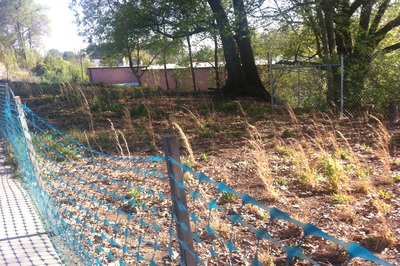
In 1999, Ryan Gravel was a graduate student at Georgia Tech studying architecture and urban planning. His now-unforgettable thesis opens with the words, “The project of the modern city was built only in fragments, and the challenge now is to remodel and augment the different parts of the city without destroying them.”
A challenge indeed. Particularly in the case of Atlanta, which was Gravel’s focus in the thesis. Forbes once called Atlanta one of the most disjointed cities in the country: there’s no grid system to simplify construction selections, and the downtown neighborhoods are markedly divided.
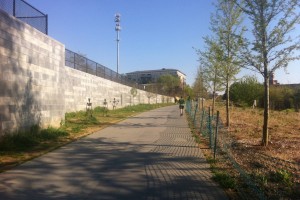
But Gravel, who grew up in Chamblee—a northeastern suburb of Atlanta, about a half-hour drive from the BeltLine— and has lived his whole life in the metro area, saw potential to fix this disconnect in the city’s history as a rail hub. The railways were primitive, sure. But they provided the city with a kind of efficiency and connectedness that hasn’t been seen since. So Gravel studied up on the current states of the rail corridors, and found that by and large, they weren’t being used. But Gravel felt that that abandoned land alongside the corridor had tons of potential.
“A lot of communities that used to have those kinds of [attached] qualities back when there were streetcars, they’re gone,” Gravel offers. “So the kernel of the idea was to reuse the corridor for transportation and then the associated redevelopment of all the abandoned industrial land that follows those railroads.”
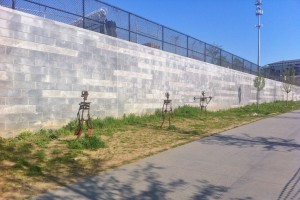
So he put two and two together, and his thesis (aptly titled “Belt Line – Atlanta as a Reflection of Public Policy”) proposed “new lighter transit lines could be woven throughout the city.” These lines would pay tribute to the city’s past as a rail center (old-fashioned streetcars), but also encourage residents to get around in fresh, environmentally-friendly and modern ways (through bike and hiking trails).
Gravel rails (pun very much intended) against Atlanta being a “car city.” The freeways were built to relieve congestion, but, he says, they’ve only made the city feel more frantic.
“The design of infrastructure influences urban development…and the interstate highway system has created a very different but recognizable pattern,” Gravel says. “I meant to revitalize that…and do that through transit. And that would encourage compact, mixed-use redevelopment.”
Gravel speaks academically—in the form of a true architect, like someone who really has spent nearly all of his adult life studying up on this phenomenon.
Indeed, it’s obvious that Gravel knows his stuff about urban infrastructure. His thesis cites cities around the world as models for an efficient transportation system:
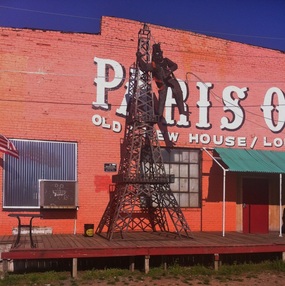
Paris with the Metro, Chicago with the El, Berlin with the Onkel Toms Hutte. And when we talk, he tells me he’s involved in about 30 similar projects nationwide, and rattles off a list of cities he’s working with to help develop their own unique versions of the BeltLine. He mentions, among others, New York’s High Line (a green space and walkway situated above a historic freight line), Los Angeles’ River (a similar idea, but along the river), Houston’s Green Spaces, and Cleveland’s aspirations for a bridge project.
“I think the BeltLine is part of a movement of the sort of catalytic construction projects,” Gravel explains. “People in different communities getting involved to enact change in their community and to create something interesting. What’s really cool is that most of them are tied to the origin of the place. So Atlanta’s a railway town and here we are reinventing the railroad as a new infrastructure for the future…L.A. is the same thing. I mean, L.A.’s downtown is where it is because of the river, and who even knew they had a river? So it’s pretty cool that they are making the future around an authentic piece of the town, their reason for being.”
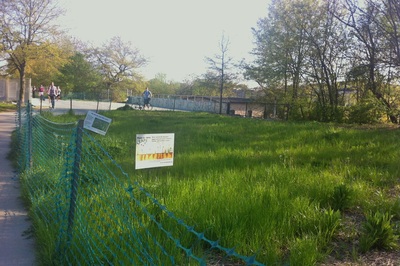
He continues—it’s easy to see that this is what makes him the proudest.
“The cool thing about it is that we’re kind of learning from each other,” Gravel continues. “So we were in similar positions, in the early stages of getting [the BeltLine] off the ground and we tried to learn from [the High Line]. And it’s cool that the people who work on these projects across the country are willing to work together and willing to learn from each other.”
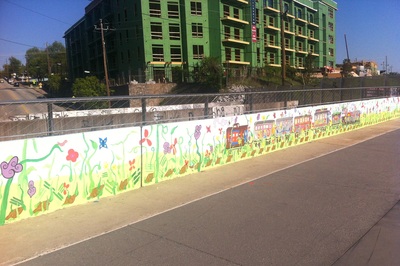
It’s safe to say that Gravel’s world has gotten bigger: all the way from a thesis to a nation-wide phenomenon. But at the same time that his plans are being realized on a larger scale, he also has to hone in on the micro-details. It’s his job to both see the big picture and to make the nitty-gritty work.
And he really loves it. He talks to me animatedly about the ramps, trees and stairways that they’re hoping to implement in the BeltLine over the next year.
“Today, I was just talking to a woman who’s trying to start a business for urban agriculture and edible plants along the BeltLine,” Gravel says. “And so there’s this new sort of layer that might sort of be overlaid on the larger vision, and that’s only going to make the project more interesting. Wouldn’t that be kind of cool to be walking down the trail and pick some blackberries off the vine?”

The possibilities are endless, and Gravel says a lot of the initiatives the BeltLine has ended up adopting have come to him by sheer happenstance.
He doesn’t need any help getting him excited about the BeltLine—Gravel is clearly of the mindset that urban planning itself is worth getting energized about.
But not all Atlantans feel the same way—some of them need a little motivation to see the potential in abandoned rail tracks. And that’s where initiatives like Art on the Atlanta BeltLine come in.

—
At 10th Street and Monroe Drive, at the tip of Piedmont Park (where I got lost), it either feels like you’re headed into the wilderness or an abandoned neighborhood. Grass grows wild and unkempt, and the asphalt trail is simple and unmarked. There’s no sign telling you that this is the right way.
But I guess it makes sense that way. The BeltLine’s Eastside Trail isn’t centered on the art or really on any aspect of its aesthetic; it’s about being out and about in Atlanta. Not in a car.
Still, that it’s not the center of attention doesn’t make Hense’s untitled mural under the Virginia Bridge any less enjoyable. After trekking down the rough road, I finally come to the bridge, where it feels like I have been transported. It is truly a breath of fresh air, a glimmer of color in an otherwise-gray area. It’s an abstract work, so I’m not sure what exactly I’m looking at. But it’s certain that if this burst of color and life and interest in what’s currently a dull, gray pathway is a sign of what’s to come with the BeltLine, the neighborhoods of Atlanta are going to start looking a whole lot more enchanting.
And this certainly is a sign of what’s to come. The mural is just one of dozens of works of art scattered along the BeltLine. It’s part of the permanent collection—a group of long-lasting sculptures, murals and constructions that you can find along the trail year-round. But at the height of the annual Art on the Atlanta BeltLine exhibition, in the fall, it gets even more intense: there’s art everywhere you turn. In fact, the 2013 exhibition included more than 70 works throughout a span of two months.
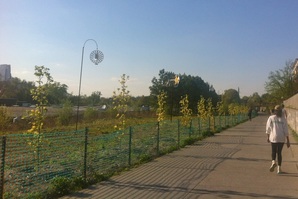
There are sculptures. There’s music. There are dance performances. There’s basically every art you could want.
But as we talk, it becomes clear that Gravel isn’t exactly an art aficionado. He’s more roused by how the project will change the way people experience the city. Still, he says, “The idea was to get people to come out to the BeltLine,” and the exhibition has certainly succeeded on that front. In the three years since its inception, hundreds of artists have participated in the project, and thousands of observers have come to check out the excitement.
The Art on the Atlanta BeltLine’s website reads, “It is a powerful conduit for everyone in the Atlanta region to gather, connect and experience something vibrant and dynamic; something that stirs passions and creates an energy unlike anything that has ever been conceived of in our vast community.”
Dr. Catherine Ross, one of Gravel’s most devoted allies on the project, once called the BeltLine “a link from where we are to where we aspire to be.”
And that’s true both in terms of location and in terms of mindset. One day, Gravel hopes that the BeltLine will take Atlantans across the city swiftly and effectively. And the artists hope that their work will make the ride a little more enjoyable.
“It’s been a learning experience for me,” says Gravel. “It’s been evolving. I mean, you wouldn’t want this to be exactly what was in some kid’s school paper, right?”
It’s true—the project has undergone many changes. But if the success of Gravel’s initial vision is any indication, maybe his school paper isn’t such a bad thing to aspire to after all.
Take a look at the details of the BeltLine’s progress, and how to get to it yourself:
[timeline src=”https://docs.google.com/spreadsheet/ccc?key=0AqkWlOPdrtLtdFNPR01vZXVpTzRERmVUZUFHeGtNaFE&usp=drive_web#gid=0″ width=”100%” height=”650″ font=”Bevan-PotanoSans” maptype=”toner” lang=”en” ]
An (Edgewood) Avenue crawl
Friday night at Church
It’s Friday in Atlanta, and you’re sick of dinner and a movie. Take a walk down Edgewood and you’ll see a sign for “Sister Louisa’s Church of the Living Room and Ping Pong Emporium.”
Known to savvy, ATL locals as “Church”, this bar is known for its quirky features like church organ karaoke.
-
“Church” was spontaneously founded in 2010 by a former divinity student named Grant Henry. (His alter ego is “Sister Louisa”, a fallen nun turned folk artist)
-
 CHURCH (It’s a Trucker Hat!) pic.twitter.com/xjfsIEBgDt
CHURCH (It’s a Trucker Hat!) pic.twitter.com/xjfsIEBgDt -
The New York Times describes Church as a place that, “..plays with, and spoofs, church culture. Karaoke is
performed in choir robes, and walls are decorated with faux-religious pop art.” -
 Jesus was a hippie
Jesus was a hippie
hanging out with the people at the Chapel Bar at CHURCH. pic.twitter.com/ifgdmwMywi -
His bar became so successful, it’s open on almost every holiday. So if you have been searching for a hiding place during Christmas/Thanksgiving/50th birthday parties, now you know about Church.
-
I mean, if it’s good enough for Jessica Alba, it should be good enough for you.
-
 JAH:
JAH:
Jessica Alba Henry at CHURCH pic.twitter.com/iiBypzLpch -
Artwork, religion, and booze, y’all.
No,this is not the service entry way. -
Have a hankering for harmonicas?
-
How about doing a little this?
-
And listening to this? …….It will sound a little better after you’ve had a few
-
Don’t let the title fool you. There is next to nothing holy about this place
-
Earliest I’ve ever been to church on a Sunday #brodown @ Sister Louisa’s Church of the Living Room and… http://instagram.com/p/jV00tgKLLz/
-
Not your cup of tea? Well, have a nice day, they aren’t changing for anyone.
-
So if you find Sunday services lackluster, try Jesus with a side of whiskey!
![]()
The walls are alive with the art of many
Old Fourth Ward Arts Festival
2013 was the first year that the Atlanta Foundation for Public Spaces came to the Old Fourth Ward, deciding that the neighborhood needed a special way to celebrate its sense of community. The resulting affair was the two-day Old Fourth Ward Arts Festival.
 But with the sense of pride the neighborhood evokes for the event, the amazing turnout, and the sheer number of exhibitors and entertainers they’ve attracted, naturally they’re returning for 2014. And you’d never guess that this was a brand-new endeavor less than a year ago.
But with the sense of pride the neighborhood evokes for the event, the amazing turnout, and the sheer number of exhibitors and entertainers they’ve attracted, naturally they’re returning for 2014. And you’d never guess that this was a brand-new endeavor less than a year ago.
Yes, the word “arts” is in the festival’s title—and there’s certainly plenty of that. Local artisans (more than 60 of them) who specialize in everything from painting to glass blowing to metal crafting got their chance to shine at the 2013 festival, and more than that number are already registered for 2014: three months before the event. And the ranges of these artists encompass the range of the region as a whole. Some are literal, some are abstract, some are meta, some are wearable, some are juvenile.
To check out some examples, visit this page.
And in addition to the visual arts, the #O4WArtsFestival (yes, that’s their hashtag) hosts a myriad of entertainers. “Local musicians only, please,” the event’s official website reads. Seriously. Other organizations from the area that have turned up at the event include Angels Among Us Pet Rescue (that means PUPPIES) and restaurant booths representing all the awesome places in the O4W (that’s both food trucks and the classic brick-and-mortars of the area).
June 29-30, 2014.
No panic at The Tabernacle: historic venue down but not out
The Tabernacle is making Atlanta news headlines after the concert hall’s floor collapsed during a sold-out January concert. An Atlanta fire marshal evacuated the hall, ushering out hundreds of Panic at the Disco! fans. To the disappointment of concertgoers and scheduled artists, the venue remains temporarily closed until further inspection. However, this historic grande dame has gone through many ups and down and has always come back to enrich downtown Atlanta. The fracture of the century-old flooring serves as a reminder of the venue’s rich history.
The Luckie Street concert hall has not always blasted rap, rock and techno beats. The elaborate four-story building once echoed church bells and songs of faith. Reverend Leonard Gaston Broughton first opened the downtown building in 1910 as a Baptist church, the Broughton Tabernacle. Broughton added an infirmary and nursing school dormitory adjacent to the church. The tabernacle grew, eventually serving 4,000 worshipers, but by the mid-1980s the church membership dwindled and the congregation relocated. During the1996 summer Olympics in Atlanta, the space was reincarnated as the House of Blues. When the House of Blues’ lease expired two years later, the building was rechristened as The Tabernacle, but this time home to a different kind of soul.
The pulpit is now a stage and The Tabernacle, as is known today, has hosted performances by Adele, Bob Dylan, Elton John, Prince and Nelly. While big enough to host top performers, its intimate atmosphere has not been lost – and neither has its elegance. Adorned with a crystal chandelier, stained glass windows, an ornate ceiling and tiled balconies, the venue merges the traditional with the hip.
And if the outstanding ambiance, acoustics, lighting and lineup aren’t enough, food and drinks are available at the multiple bars throughout the building.
The Tabernacle sits at the edge of downtown Atlanta near Centennial Park and is a regular stop for music-lovers. Now run by Live Nation Entertainment Inc., the world’s largest live music company, the historic concert hall is one of Atlanta’s and the nation’s top music venues. A crack in the floor might put the music on pause, but concerts have already been rescheduled and with a prayer, The Tabernacle will soon reopen for another chorus.
152 Luckie Street
Atlanta, GA 30303
Tel: 404.659.9022
Fax: 404.659.9086
What to do when you wake up wasted at Grady Memorial Hospital (an informative, blunt guide)
Uh oh. Apparently, you’ve miscalculated the amount of vodka shots you took on Fraternity Row. As your eyes slowly adjust, you realize with a sigh of relief that your current location does not appear to be a holding cell in jail. The panic soon wells up again when you see that you are laying down. In a hospital bed. At the place you only knew by billboards all over the ATL. Grady Memorial Hospital.
Don’t start screaming and passing out with fear quite yet. Here are the top eight things you need to know if you wind up at 80 Jesse Hill Drive.
- You have NO rights. You were drunk enough that someone assessed you needed immediate medical attention. This means they had to cycle through a list of check-offs to determine if you were capable of making informed and conscious decisions. Since you weren’t, don’t try to pull the IV out and hightail it out the sliding doors. The Grady security guards are very big and very good at what they do, you will lose.
- If you are underage, Grady WILL call your parents. So brace yourself for the barrage of texts from Mom and Dad that are about to come your way.
- You probably will have to talk to police, and depending on what you were doing at the time you decided to get sauced, you may have a few misdemeanors coming your way. Get on the phone with a lawyer ASAP.
- Since you are a student, a designated university official, most likely the Dean of Campus Life, will be arriving at your bedside. If you have decided to act a fool in the wee hours of the morning, the mood of this official will probably vary.
- Say thank you. To everyone. No matter what. You are taking up the bed of someone probably dying in the waiting room (Grady is a high volume trauma hospital) so don’t make them regret waking you up.
- As a second part to the item above, do not be sassy to your nurse/police officers/other patients.
- As scared and frustrated you might be, you will not have to worry about receiving top of the line medical attention. Lucky for you, even if you happened to have left your insurance card at the bar last night, or if you have no insurance, you will not be turned away or treated any differently. Grady is a public hospital and will not refuse anyone.
- When and if you are discharged, do not try to walk home. You are in a questionable part of Atlanta. Ask your nurse to see if you are eligible for the taxi service Grady provides for patients. At least you’ll avoid the walk of shame and get to keep your purse/wallet in the process. (Repeat Step No. 5)
Hopefully this will be your first and last involuntary trip to Grady. Go easy on the alcohol next time, and good luck.
For more information about Grady Memorial Hospital, visit their website at www.gradyhealth.org
Or call the main switchboard at (404) 616-1000








